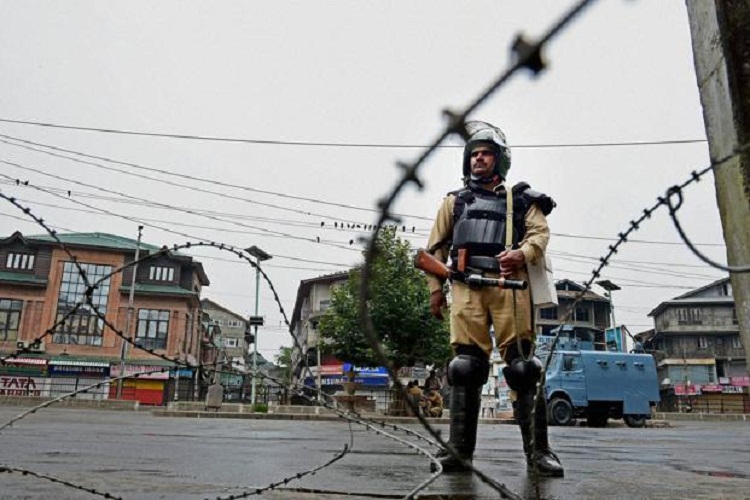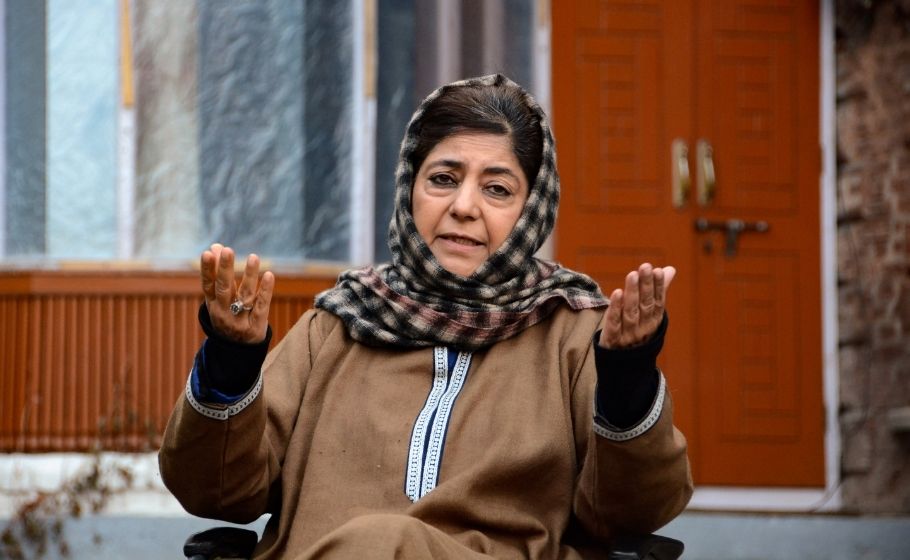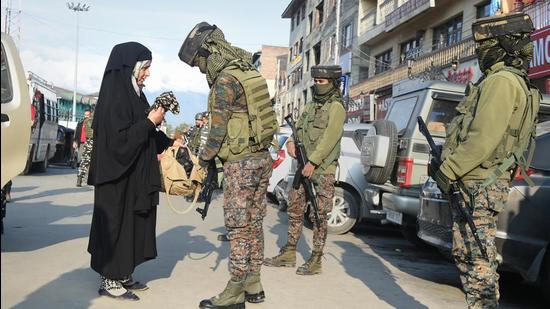
New 'dawn' yet to break in J&K, even as fear & violence grip region
For forty-two months (1,280 days), a restive Jammu and Kashmir has been without an elected government. The administration is being led by a Lieutenant Governor and a set of bureaucrats. All competing political ideological groups are involved in a battle to dominate the narrative on Kashmir’s political landscape post-August 5, 2019.

The promised new “dawn” is yet to break in the troubled region of Jammu & Kashmir. For forty-two months (1,280 days), a restive Jammu and Kashmir (J&K) has been without an elected government. The administration is being led by a Lieutenant Governor and a bunch of bureaucrats, while all the competing political ideological groups are involved in a pitched battle to dominate the political narrative of Kashmir post-August 5, 2019.
As 2021 comes to a close, has ‘normalcy’ returned to J&K and is the region witnessing a promised ‘era of development’ or do its inhabitants feel politically dispossessed as never before? Is J&K better placed today than it was three years ago or has the situation worsened with more uncertainties, anxieties and fears?
The ruling Bharatiya Janata Party (BJP) claims that J&K is witnessing a positive change since the territory lost its special status, its semi-autonomy and statehood in August 2019. Almost on a daily basis, the J&K administration issues lengthy press releases to highlight its ‘accomplishments’ in various sectors, including tourism. On December 27, the administration hosted an investment event in Jammu, paving the way for outsiders to buy non-agricultural land in J&K for investment purpose, building residential houses and Sainik Colonies. The government said that it had signed 39 MoUs worth ₹18,300 crores.
However, the facts on the ground belied the claims made by the J&K administration about the region returning to normalcy. There are no signs of developmental works either. Not only has the law-and-order situation worsened in J&K, political parties have been made redundant and an atmosphere of fear grips the region.
An uptick in violence
Apart from recording the highest-ever unemployment rate in October 2021, J&K continues to witness a spike in civilian casualties, militant strikes and gunfights. In the last three years, nearly 900 people have been killed, out of which 580 were militants, 180 were government forces personnel and 125 were civilians.
Also read: Political storm over J&K delimitation draft that gives Jammu 6 seats and Kashmir 1
Data obtained from multiple sources paint a grim picture. Although the number of foreign militants operating in J&K have declined, the recruitment of local militants continues to be on the rise. In 2020, at least 145 new youngsters joined militancy groups. In 2021, 128 youths joined the militants and 73 of these new recruits have been killed. Also, more than 500 ‘OGWs’ or over ground workers (who are the ears and eyes of underground militants) and 82 armed militants were arrested this year.
The sustained spike in militancy-related violence in Kashmir prompted Pravin Sawhney, a former Indian army officer, security analyst and author, to predict, “Plenty will happen between 2023 and 2024 general elections. Mark my words – India’s sovereignty is at stake.”
Sawhney, who is also the editor of a monthly news magazine Force (on national security and aerospace), without naming either China or Pakistan maintained that the decisions taken by the BJP government with respect to Kashmir on August 5, 2019, have “geopolitical ramifications.”
Deteriorating law and order
According to the South Asia Terrorism Portal (SATP) and police sources, at least 47 civilians (it was 33 civilians in 2020), 48 members of government forces and 190 militants have been killed in J&K from January 1 to December 30, 2021. 285 people have lost their lives in 150 militancy-related incidents this year.
On November 30, the BJP-led government informed Parliament that at least 40 civilians have been killed, while 72 were wounded in J&K in violence-related incidents till November 15, 2021. Nityanand Rai, Union Minister of State for Home, while responding to a question in the Lok Sabha, said that 35 personnel of the government forces, including J&K Police, were killed in militant attacks till November 15.
Some more militancy-related incidents have taken place since Rai’s disclosure in Parliament, which includes a major militant strike on December 13, 2021.
Militant strikes
On the 20th anniversary of the 2001 attack on the Indian parliament, armed militants in Kashmir, attacked a police bus near a police camp in Zewan in Pantha Chowk area, on the outskirts of Srinagar. The strike left three personnel of the J&K armed police dead and about a dozen wounded, according to the J&K Police.
Also read: Militants strike J&K on 20th anniversary of Parliament attack, 2 killed
Only two days before the deadly attack in Zewan, at least two J&K policemen were killed in a militant strike in north Kashmir’s Bandipora district.
While Rai said that the steps taken by the government “to protect civilians” included “proactive operations” against militants, identification and arrest of Over Ground Workers (OGWs), action against members of proscribed organisations, night patrolling and intensified frisking at checkpoints etc., the situation on the ground shows little or no signs of improvement.
Apart from the usual violent incidents in the south, north and central parts of J&K, Srinagar too is witnessing recurrent encounters between militants and government forces personnel besides the targeted attacks on non-combatants, including members of the minority communities and skilled migrant workers from outside Kashmir.
Also read: Five killings in 48 hours rock Kashmir, shatter deceptive calm

In October 2021, 13 civilians were killed in J&K. The number was the highest-ever in a month in the last two years and the fourth-highest since 2012.
Encounters and controversies
In recent times, militant attacks, encounters and controversial shootouts have taken place in Pantha Chowk, Rangreth, Rambagh, Hyderpora, Bemina, Nawakadal, Jamalata and other areas of the Srinagar City.
Even the Chenab Valley and Pir Panchal regions in Jammu province have seen a surge in violence. In mid-October 2021, nine personnel of the Indian army were killed in a major anti-militancy operation in the forests of Mendhar, in Poonch. The slain, according to a defence spokesman, included junior commissioned officers (JCOs), Subedar, Naib Subedar, Naik and riflemen.
Moreover, several encounters including the ones in Amshipora in south Kashmir’s Shopian district (2020), HMT on the outskirts of Srinagar (2020), Hyderpora in Srinagar (2021), came under a cloud of suspicion. Eyewitnesses and family members alleged that their kin were killed in ‘fake encounters’. After public protests and political outrage, the administration had to return the bodies of three civilians to their families in Rajouri, who were killed in Shopian, and mortal remains of two more civilians to the families in Srinagar.
Also read: Hyderpora deaths: Magisterial probe begins, bodies to be handed over to kin
The National Conference (NC) and the People’s Democratic Party (PDP), J&K’s two major unionist parties, while blaming the BJP for “deteriorating ground situation” and for “anti-Kashmir policies” argued that bureaucracy is “out of touch with the people” and busy “painting a false narrative of normalcy”.
Omar Abdullah, former chief minister and vice-president of NC, said, “Our state was split, our Constitution discarded, our Legislative Council was abolished. The constitutional guarantees were eroded and its abrogation was made a perfect pretext for rescinding our constitutional status. All we are asking is that where is the much touted change? A new dawn is arising, we were told. Where is it? Where is that era of development, investment, job extravaganza and inclusion that we were promised, beckons us?”
According to Abdullah, peace in Kashmir will remain “elusive as ever with the footprint of forces personnel increasing and new security bunkers being constructed across Srinagar.”
Newly constructed concrete bunkers in every nook and cranny of Kashmir, especially in the Srinagar city, make the region appear like a battlefield. The increased presence of government forces personnel in civilian areas has further deepened the anxiety of the people in the valley.
Addressing the Workers Convention in central Kashmir’s Ganderbal district, junior Abdullah said that, “Post abrogation of Article 370, we were told that peace will return to J&K. However the situation on ground completely belies that claim. In the last 24 hours, we witnessed an encounter in Rangreth, an ambush on J&K police personnel which resulted in the unfortunate killing of three policemen and injuries to scores.”
Mehbooba Mufti, former chief minister and president of PDP, accused the administration of placing her under house arrest often and denying a level playing field to her party. Recently, the government disallowed the party’s youth convention citing COVID19 restrictions.
As J&K Police arrested two women from Rose Enclave Rawalpora, Srinagar, in the aftermath of a brief chance encounter with militants (December 13) on charges of raising “anti-national slogans”, Mufti hit hard at the law enforcing agencies. “Arresting women in Kashmir marks a new low for the administration that persecutes civilians only to please their masters in Delhi. The situation is getting worse and instead of reaching out to the people, GoI (Government of India) is pushing them to the wall,” she said.

“Everything has changed in J&K since August 2019. In a sense that every aspect of life has been adversely affected — be it political, social, economic, emotional, psychological etc. People of J&K have been systematically disempowered in every sphere of life,” she had told The Federal in an exclusive interview in October.
In September, hardliner Syed Ali Geelani of the Tehreek-e-Hurriyat, a pro-Pakistan amalgam, passed away at his Hyderpora residence in Srinagar after a prolonged illness. A former elected legislator, the ailing 92-year-old had been under house detention for more than a decade.
In December, the Delimitation Commission proposed an increase of six seats in Jammu region and only one for Kashmir, and this recommendation was rejected by all the major political parties.
Also read: Exclusive | Shah’s J&K visit refused to acknowledge realities: Mehbooba
Record Unemployment
A recent survey released by the Centre for Monitoring Indian Economy [CMIE] painted a bleak picture of J&K’s economy. The region registered its highest unemployment rate, ever. At present, the unemployment rate in J&K has touched 22 per cent, the worst among all the states and Union Territories in India.
J&K has the second-highest unemployed graduates and post-graduates, while Nagaland tops the list. A periodical labour force survey carried out by the National Statistical Officer showed that unemployment in J&K is on the rise among both women and men.
“Every sector is witnessing job losses. The unemployment numbers of September and October, 2021, show that over nine lakh people among J&K’s total labour force of 44,00,000 (44 lakh) have lost their jobs. This situation is pushing households towards abject poverty,” Ejaz Ayoub, a Srinagar-based economic analyst, told The Federal.
Ayoub argued that J&K is “going through a tough economic winter, which is fast metamorphosing into an economic black hole.”
Economy in doldrums
On its part, the administration claimed that tourism activity picked up. Releasing figures on December 13, the J&K tourism department said that 1,27,605 travellers visited J&K in November, 2021. “Jammu and Kashmir has crossed the mark of highest tourist footfall in November with 1,27,605 tourists,” the department said.
However, according to the Srinagar-based influential trade body Kashmir Chamber of Commerce and Industries (KCCI), “Since August 2019, the J&K economy has suffered losses worth ₹50,000 Crore.” According to Sheikh Ashiq, president KCCI, “The last three years have been devastating for us. Initially, our estimates showed losses worth ₹40,000 crore from August 2019 till December 2020. This year, we have incurred losses worth ₹10,000 Crore.”
“Successive lockdowns since August 2019 have broken the back of our economy,” he added. During any lockdown (be it the shutdowns, curfews or lockdowns related to the COVID-19 pandemic etc), our economy takes a hit. It primarily affects 500,000 daily wagers who earn from hand-to-mouth,” Ashiq told The Federal.
He added: “The first victims of lockdowns and shutdowns in the Kashmir valley are daily wagers, tour operators and those associated with the IT-sector, tour and travel and hospitality industry. The revival will take a lot of time and a lot of effort.”
The J&K administration selectively picks tourism-related data with the aim to showcase normalcy. It, however, does not talk much about the rise in civilian casualties, deteriorating law-and-order, rising unemployment, Internet outages, losses to economy, media gags, and the atmosphere of uncertainty and fear.

Stifling dissent
On November 22, Kashmir valley’s leading human rights defender Khurram Parvez, who is also chairperson of the Philippines-based Asian Federation Against Involuntary Disappearances (AFAD), was arrested by the National Investigation Agency (NIA) under the Unlawful Activities (Prevention) Act (UAPA). Global bodies including the United Nations, the Norway-based Rafto Foundation, FORUM-ASIA and AFAD etc, deplored Parvez’s arrest while demanding his urgent release.
According to available data, the J&K administration booked more than 2,300 people in the region since August 2019, in over 1,200 cases, under the UAPA. Separately, as many as 954 people were detained under the stringent Public Safety Act (PSA). Of these, 699 people were detained in 2019, and 160 more in 2020. In 2021, nearly a 100 were held under PSA till July-end. About 300 of these continue to remain under confinement.
About 7,357 people, including three former chief ministers and prominent civil society actors and political leaders of various ideological hues, were put under detention in the run up to the August 5, 2019, decision. This, the Union ministry for home (MHA), told Parliament.
Gag on media
In 2020, the J&K administration introduced a controversial Media Policy. It empowers a clerk or a bureaucrat in the Department of Information and Public Relations (DIPR) to initiate a legal action against journalists, reporters, owners and editors by declaring any news item as ‘fake, anti-national or seditious’.
More than 50 journalists have been summoned to various police stations for questioning; some of them pressurised to reveal sources. There have been cases filed against journalists under stringent laws and some of them have been put under the No Fly List. Individual journalists were made to vacate their quarters owned by the Estates Department; the office of Kashmir Times was sealed while another newspaper, Greater Kashmir, was forced to leave its office in the Srinagar Press Enclave; and advertisements were curtailed or withheld to some of the newspapers.
“Post-August 5, 2019, the gag on the media is unparalleled. Documentation of human rights abuse has been made pretty difficult, if not impossible. Moreover, traditional unionist and separatist politics in the region has been made redundant,” the valley-based analyst Riyaz Ahmad told The Federal.


